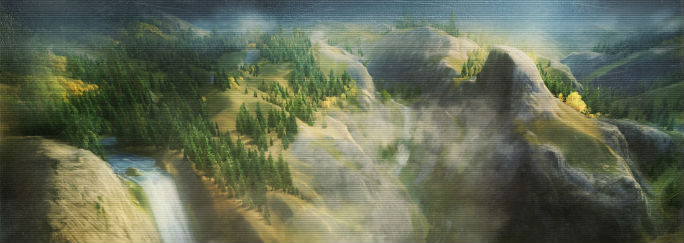-
![LANG-CODE-KEY]() LANG_NAME_KEY
LANG_NAME_KEY

Pilots!
Not only do the developers add new maps to World of Warplanes in almost every update, they also take the time to revise old maps in order to bring them in line with new production standards. To keep track of the evolution of old and new maps in the game, we’re launching this new Mapping the Progress series. Let us know in the forums if you have a particular favorite map you'd like to see in a future article!
National Park offers picturesque granite plateaus and deep canyons. The advancement of the frontlines has been halted by complex terrain. Air superiority is the key to seizing the high ground and advancing along the riverbed in the center of the valley.
| Old National Park (pre Update 1.5) | Stats | National Park 2.0 (Update 1.5) |
|---|---|---|
|
(click to enlarge) |
Size7.2 x 7.2km TiersI-V TypeSummer Elevation0 - 1300m |
(click to enlarge) |
The first thing you’ll notice when entering a battle on the revamped National Park are the new spawn points for either team. Instead of spawning in the lower right and top left corner, teams now spawn on the top right and lower left. Overall, there are three spawn points per team: the main one at C8 and H2, and two flanks at B3/D2 and G9/J7. Incidentally, this also means that, unlike the old version, now all planes spawn directly over (or in close vicinity) of a protective base.
When you look at the layout of the map, you’ll see that the old bases seem to have disappeared. In truth, both bases still exist on the new map; however, their appearance and roles have changed completely.
|
|
|
|
|
|
The evolution of the bases before... |
... and after Update 1.5 |
||
One base (a group of houses with an airfield, AA-guns and the main hangar) remains, and now makes up the embattled fortification at J9. The other one has perished, with only a few remnants such as burned-out houses and tracks at B4, reminding pilots of its prior existence. What’s important to know is that since the introduction of complex ground targets in the latest update, both bases have no strategic value anymore. Although you can see them, these structures no longer house an HQ, nor contain any other ground targets.
Instead, what you now find on National Park 2.0 is a collection of grouped convoys and tanks that act as the new bases. You can find these ground targets placed sporadically along the central riverbed, or grouped at B3/D2 and G9/J7, respectively. The two southeastern groups are made up of 10 ground targets, each consisting of multiple immobile convoys and tanks.
On the northeastern side of the map (D2/B4), the entrance to the central valley is guarded by five ground targets for each team, consisting likewise of a couple of convoys and tank squads. These five units feature medium to heavy-armored tanks that can damage and destroy your plane at up to 1.5km of distance. Be sure to stay far away from them if you’re flying a light fighter!
The main valley that was already present in prior versions of the game also remains. However, its look and layout have been modified to reflect the new role that complex ground targets play.
|
|
|
|
|
|
National Park pre-1.5... |
... and what the valley looks like now! |
||
The riverbed has been enlarged, while the surrounding mountain walls have been heightened. The new design creates more of an enclosed corridor that planes will have to descend into – if they dare! Previously, the valley was free of ground targets, and presented the main fighting ground for fighters on the map. Now, the river is lined with ground targets, making it a dangerous place to fly over for light-armored hunters.
Both teams’ valley side is capped by another dense collection of six convoys and tanks at H2 and C8. While the southwest group is in rather open terrain (which makes them an attractive target for attack aircraft), the northeast targets are located in a natural cul-de-sac, surrounded by a high mountain walls from all but the riverside. Taking out these targets, which are the closest you’ll come to an actual fortification on National Park 2.0, may prove more challenging because of the limited room that pilots have to operate here.
Last but not least, we must also say a word about the visual highlight of this map. It comes in the form of a gigantic waterfall in the middle of the valley at F3. While it’s true that there was more than just one waterfall in the original version of National Park, what always seemed strange about those falls was the fact that it was never quite clear where they originated from. This has been corrected for National Park 2.0, where the majestic cataract now springs from an elevated mountain lake at G1 that is neatly tucked away a few meters below a formation of all-engulfing clouds.
 |
 |
 |